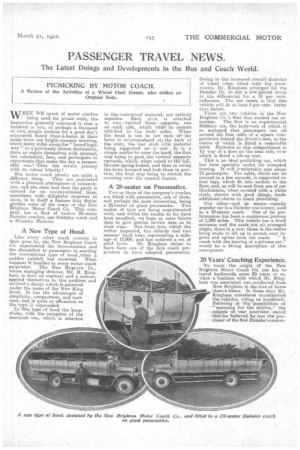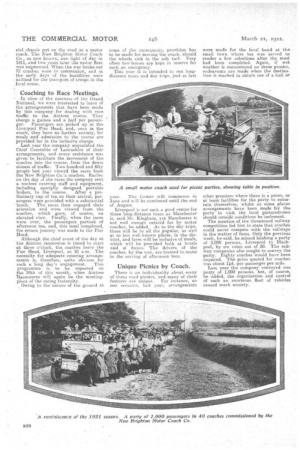PASSENGER TRAVEL NEWS.
Page 27

Page 28

If you've noticed an error in this article please click here to report it so we can fix it.
The Latest Doings and Developments in the Bus and Coach World.
PICNICKING BY MOTOR COACH.
A Review of the Activities of a Wirral Fleet Owner, who strikes an Original Note.
WHEN WE speak of motor coaches lf being used for pienio work, the impression generally' conveyed is that a hundred or two, or perhaps a thousand or two, people anxious for a good day's enjoyment board chars-e-banes in their home town one bright-summer morning, travel many miles along the "broad highway '? to a previously chosen dertination, there to regale themseltes with unusual; but substantial, fare, and participate in enjoyments .that. make the day a memorable one. t Then the return journey with its robust hilarity !
But motor coach picnics are quite a
different thing. They are associated with a pleasant atmosphere of romanCeism, and the mere fact that the party is catered for on unconventional lines, sometimes with delightful surprises in store, is in itself a, feature that distinguishes some of the tears of the New Brighton Motor Coach Co. This company has a fleet of twelve 28-seater Daimler coaches, one Siddeley coach and a 10-seater Daimler.
A New Type of Hood.
Like every other coach concern in days gone by, the New Brighton Coach Co. experienced the inconvenience and the discomfort to passengers in erecting the conventional type of hood ,when a sudden rainfall has occurred. What happens is familiar to every motor coach proprietor. The New Brighton Co., whose managing director, Mr. H. Kinghare, is both an engineer and a caterer, applied themselves to this problem and evolved a design which is patented under the name of the New King hood. It has the advantages of simplicity, compactness, and neatness, and is quite as efficacious as the type it superseded. In this type of hood, the hoopsticks, with the exception of the rearmost. one, which is attached
to theswaterproof material, are' entirely .separate. Each .tick is attached to two vertical brass supports, one on each 'side, which slide, in• sockets attached to the body sides. When the hood is not in use each of the bows is accommodated at the back of the seats, the rear stick with material being supported on a , rest. It is a. simple matter to raise the hood, the first step being to .push the vertical supports upwards, which; when raised, to-the full, become spring-locked, and then to swing the bows forward and lock them in position, the final step being to stretch the covering over the erected frames.
A 28-seater on Pneumatics.
Two or three of the company's coaches are fitted with pneumatics, one of them, and perhaps the most interesting, being a 28-seater on giant pneumatics. Two makes of tyre are being experimented with, and whilst the results so far have been excellent, we hive at some future date to give precise service data as to their wear. One front tyre, -which the writer inspected, has already had two seasons' hard wear, representing a mileage of 15,000, and has outlived a set of solid tyres. Mr. Kingham claims to have been one of the first coach proprietors to have adopted pneumatics. Owing to the increased overall diameter of wheel when fitted with big pneumatics, Mr. King-ham arranged for the Daimler Co. to put a low-geared worm in the differential for a 10 per • cent. reduction. The net result is that this vehicle will do at feast 5 per ceht. better than before.
There are two vehicles in the New Brighton Co.'s fleet that excited our at. tention. The first is an experimental Siddeley car, the bodywork of which is so arranged that passengers can sit around the four sides of a square compartment behind the driver's seat, in the centre of which is fitted a removable table. Entrance to this compartment is by way of a. door on the near side, over i which s fitted a lift-up seat..
This is an ideal picnicking car, which has been specially useful for extended touring. It will cemfortably seat aboue 12 passengers. The table, which can be erected in a few seconds, is supported on four legs, which fit into sockets irs the floor, and, as will be seen from one of our illustrations, when covered with a white cloth, strewn with good things, lends additional charm to coach picnicking.
The other—and in season—equally popular car is a Daimler one-tonner, used
as a 10-seater coach. One of its performances has been a continuous journey of 1,200 miles. This vehicle has a front entrance and the seats are all arranged single, three in a row, those in the centre being made to lift up to permit easy ingress and egress from the coach. " A coach with the bearing of a private car," would be a fitting description of this conveyance.
.20 Years' Coaching Experience.
To trace the origin of the New Brighton Motor Coach Co. one has to travel backwards some 20 years or so, when a business with which. Mr. Kingham was associated was conducted from
New Brighton in the hire of horse chars-à-hence. In those days Mr. Kingharn sometimes accompanied the vehicles, riding on horseback. Believing in the possibilities of "motoring for the million," the subject,' of -our interview stated that the believed he was the purchaser of the first Daimler rummer
cial chassle put on the road as a motor coach. The New Brighton Motor Coach Co., as now known, saw light of day in 1911, and two years later the motor beet was augmented. When the war broke out 12 coaches were in commission, and in the early days of the hostilities were • utilized for the transport of troops in the • local areas.. . .
Coaching to Race Meetings.
. In view of the nearness of the Grand National, we were interested to learn of the arrangements that have been made by this company, for dealing with race traffic to the Aintree course. They charge a guinea and a half per passenger. Passengers are picked up at the Liverpool Pier Head, and, once in the coach, they have no further anxiety, for meals and admission to the course are provided for in the inclusive charge.
Last year the company acquainted the Chief Constable of Lancashire of their arrangements, and every assistance was given to facilitate the movement of the coaches into the course, from the dense stream of traffic. Two hundred and fifty people last year viewed the races from " the New Brighton Co.'s coaches. Earlier on the day ot the races the company sent a nucleus catering staff and equipment, including speciitily designed portable
boilers, to the course. After a preliminary cup of tea on their arrival, passengers were provided with a substantial
" lunch. The races then engaged their attention and were viewed from the coaches, which gave, of course, an elevated view. Finally, when the races were over, the passangers partook of afternoon tea, and, this meal completed, the return' journey was made to the Pier Head.
Although the chief event of the day at the Aintree racecourse is timed to start at three o'clock, the coaches leave the Pier Head, Liverpool, at 10 a.m. The necessity for adequate catering arrangeTrtents is, therefore, quite obvious for such a long day's engagement. This programme is to be repeated on the 24th of this month, when Aintree 'Racecourse will again be the meetingplace of the racing fraternity. Owing to the nature of the ground at some of the racecourses, provision has to be made for moving the coach, should the wheels sink in the soft turf. Very often tow-horses are kept in reserve for such" art emergency. This year it is intended to run longdistance tours and day trips, just as last year. The former will coinmence in June and will be continued until the end of August.
Liverpool is not. such a good centre for these long-distance tours as Manchester is, said Mr. Hingham, yet Manchester is not well enough catered for by motor coaches, he added. As to the day trips, these will be to all the popular, as well as to less well-known places, in the district, and fares will be inclusive of meals, which will be provided both at hotels and al fresco. The drivers of the coaches, by the way, are trained to assist in the serving of afternoon teas.
Unique Picnics by Coach.
There is an individuality about many of these road picnics, and many of their features are unique. For instance, on one occasion, la2.t year, arrangements were made for the local band at the small town whero tea was served to render a few selections after the meal had been completed. Again, if wet weather is encountered on these picnics, endeavours are made when the destination is reached to obtain use of a hall or other premises wherre there is a piano, or at least facilities for the party to entertain themselves, whilst at some places arrangements have been made for the party to visit the local picturedrome should outside conditions he inclement.
The mention of the threatened railway competition led him to state that coaches could never compete with the railways in the matter of fares. Only the previous week, he said, he missed booking a party of 2,000 persons, Liverpool to Blackpool, by six votes out of .50. The railway companies also sought to convey the party. Eighty coaches would have been required. The price quoted for coaches was about lid. per passenger per mile.
• 1,ast year the company conveyed one pagty of 1,000 persons, hut, of course, he added, the organization and control of such an enormous fleet of vehicles caused much anxiety.


































